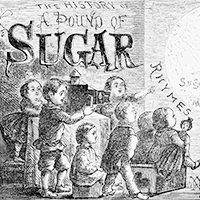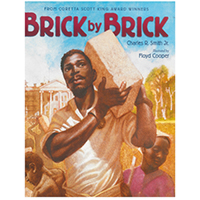
Children's stories in the 19th century that taught how commodities such as sugar were made often left out the human element of production, including slave labor. Information sciences professor Elizabeth Hoiem analyzed such production stories and created a digital resource to help teachers and librarians evaluate the literature.
Photo by L. Brian Stauffer
CHAMPAIGN, Ill. — A genre of children's literature that taught about how things were made during the Industrial Revolution often left out the human element, including the slave labor that contributed to the production of many commodities.
Elizabeth Hoiem, a professor in the School of Information Sciences at the University of Illinois Urbana-Champaign who studies children's literature and material culture, analyzed such "production stories" in an article in the journal Children's Literature in Education. She also created an online resource about the genre.

The cover illustration of "The History of a Pound of Sugar" (1861), by William Newman, shows white English children watching a magic lantern show about sugar cane.
Courtesy Elizabeth Hoiem
Hoiem was interested in how children learned about new scientific discoveries and new technologies during the Industrial Revolution. Popular children's books that appeared in the 19th century examined the production of popular commodities – sugar; cotton and textiles; bread; energy sources and mining; and transportation and shipping.
"A production story is a nonfiction story that explains how seemingly insignificant everyday things, like food or clothing, are created, transported and consumed in an industrial global economy," Hoiem said.
The genre remains popular today in books, videos and TV shows such as "How It's Made," "Modern Marvels" and "Dirty Jobs."
The stories Hoiem studied from the 19th century to the present are formulaic, and the formula of the story makes it easy to hide the human element of the processes, she said.
"It promises to reveal something surprising and to take you into a secret place usually closed to view and open up some vista of knowledge," Hoiem said. "This promise to reveal something surprising deflects attention from what is not revealed. It becomes a method for concealing particular kinds of information. What it usually conceals is the human side of making things."
The industries consistently represented in the stories were complicit in slavery, child labor, colonization, abuses of migrant workers and imperialist resource extraction, she said. A focus on technology makes it hard to explore such human elements that are problematic. In the 19th-century production stories, for instance, illustrations often avoided showing the faces of workers. Today, some technology videos might show close-ups of a machine, but avoid faces. In other cases, the human details are deceptive.

Hoiem cites "Brick by Brick" (2015) by Charles R. Smith, illustrated by Floyd Cooper, as a positive example of a production story. It resists the genre's formula by showing the humanity of the enslaved persons who built the White House, she said.
Courtesy Elizabeth Hoiem
"Images showed enslaved people in the fields taking a break to eat lunch. That decision, which is really common in a book about sugar, is making the argument: 'These people make food for you, and they also get enough to eat,'" Hoiem said. "It's a lie. People starved to death working in the sugar fields."
The techniques used in the stories including hearing from an authoritative narrator rather than the voice of a worker in describing the production processes, and using scientific discourse – facts and figures – to mask the choice to exclude the social relations of manufacturing. The stories "overwhelmingly celebrate technological progress … (and) tend to undervalue worker intelligence and experiences," Hoiem wrote in the article.
The books often focus on commodities that have a positive meaning for consumers, which is at odds with the suffering required to make them, Hoiem said. For example, sugar was associated with good behavior and children getting treats, and tea was associated with femininity.
The books almost always end with someone eating or using the product, symbolically affirming the conditions under which they were made. Such a narrative speaks to privileged readers with purchasing power rather than those who identify with the workers making the product, and so encourage consumption as the primary form of political engagement, she said.
The highly politicized genre also was used by abolitionists to show the cruelty of slavery and to urge boycotts of sugar and other products relying on slave labor, Hoiem said.
The supplementary digital resource she created, "Sugar production stories for children and the history of slavery," provides a visual analysis of the illustrated texts she studied. Hoiem said her goal is to help teachers and librarians evaluate the literature when they are seeking quality books on STEM subjects and Black history, and to show how "STEM books may participate in this long tradition of celebrating technology and hiding labor."






